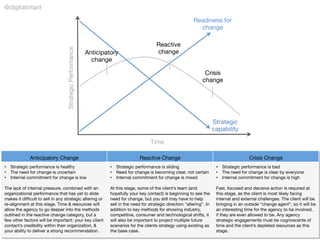Readiness change-strategic capability-agency engagement
- 1. Anticipatory Change Reactive Change Crisis Change ŌĆóŌĆ» Strategic performance is healthy ŌĆóŌĆ» The need for change is uncertain ŌĆóŌĆ» Internal commitment for change is low The lack of internal pressure, combined with an organizational performance that has yet to slide makes it dif’¼ücult to sell in any strategic altering or re-alignment at this stage. Time & resources will allow the agency to go deeper into the methods outlined in the reactive change category, but a few other factors will be important: your key client contactŌĆÖs credibility within their organization, & your ability to deliver a strong recommendation. ŌĆóŌĆ» Strategic performance is sliding ŌĆóŌĆ» Need for change is becoming clear, not certain ŌĆóŌĆ» Internal commitment for change is mixed At this stage, some of the clientŌĆÖs team (and hopefully your key contact) is beginning to see the need for change, but you still may have to help sell in the need for strategic direction ŌĆ£alteringŌĆØ. In addition to key methods for showing industry, competitive, consumer and technological shifts, it will also be important to project multiple future scenarios for the clients strategy using existing as the base case. ŌĆóŌĆ» Strategic performance is bad ŌĆóŌĆ» The need for change is clear by everyone ŌĆóŌĆ» Internal commitment for change is high Fast, focused and decisive action is required at this stage, as the client is most likely facing internal and external challenges. The client will be bringing in an outside ŌĆ£change agentŌĆØ, so it will be an interesting time for the agency to be involved, if they are even allowed to be. Any agency strategic engagements must be cognoscente of time and the clientŌĆÖs depleted resources as this stage. Reactive change Crisis change Readiness for change Time StrategicPerformance Anticipatory change Strategic capability @digitalinfant

